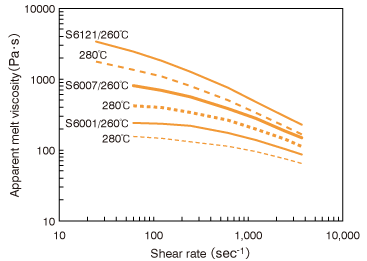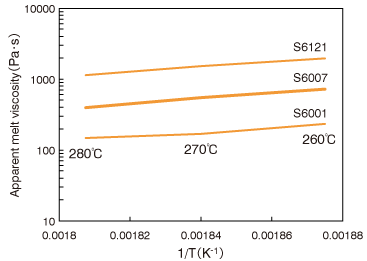Thermal Properties and Flow Dynamics
Table 5 shows the thermal properties and melt viscosity of Nylon-MXD6. Fig. 3 shows the relationship between the shear rate and the melt viscosity. Fig. 4 shows the relationship between the temperature and the melt viscosity.
Table 5 Thermal Properties and Melt Viscosity of Nylon-MXD6
| Property | Measuring Method | Unit | Grades | |||
|---|---|---|---|---|---|---|
| S6001 | S6007 | S6121 | ||||
| Melting Point | DSC | ℃ | 240±5 | 240±5 | 240±5 | |
| Glass-Transition Temperature | DSC | ℃ | 85 | 85 | 85 | |
| Molding Temperature | ℃ | 250~290 | 250~290 | 250~290 | ||
| Melt Viscosity | 260℃ |
Capillograph |
Pa・s | 300 | 780 | 1,960 |
| 270℃ | 220 | 550 | 1,640 | |||
| 280℃ | 200 | 400 | 1,200 | |||
| Coefficient of Thermal Expansion | ASTMD696 | cm/cm℃ | 5.1×10-5 | 5.1×10-5 | 5.1×10-5 | |
Fig. 3 Melt Viscosity and Shear Rate

Equipment used: Capillograph 1C by Toyo Seiki Seisaku-sho, Ltd.
Die: 1mmφ ×10mmL
Fig.4 Temperature dependence of melt viscosity

Equipment used:Capillograph1C by Toyo Seiki Seisaku-sho, Ltd.
Die: 1mmφ ×10mmL
Inquiries Concerning Products
Green Energy & Chemicals Business Sector
High-performance Products Division
HP Material Department
TEL:+81-3-3283-4800 / FAX:+81-3-3214-0938
